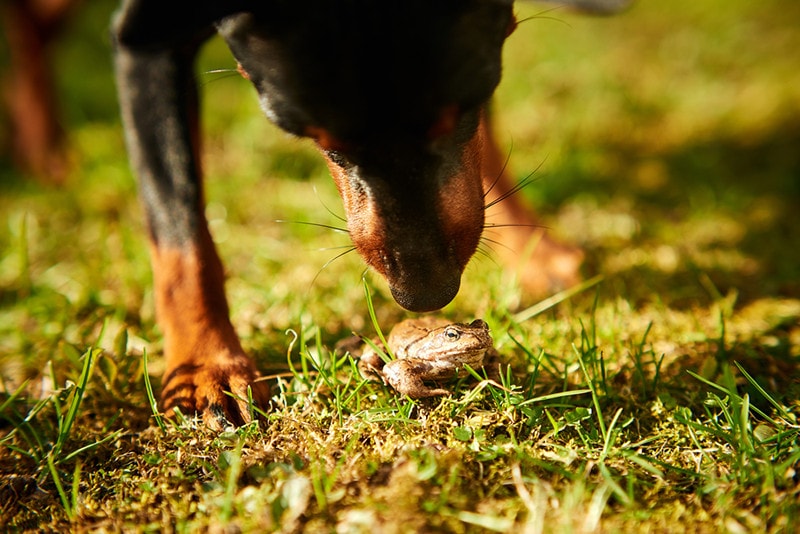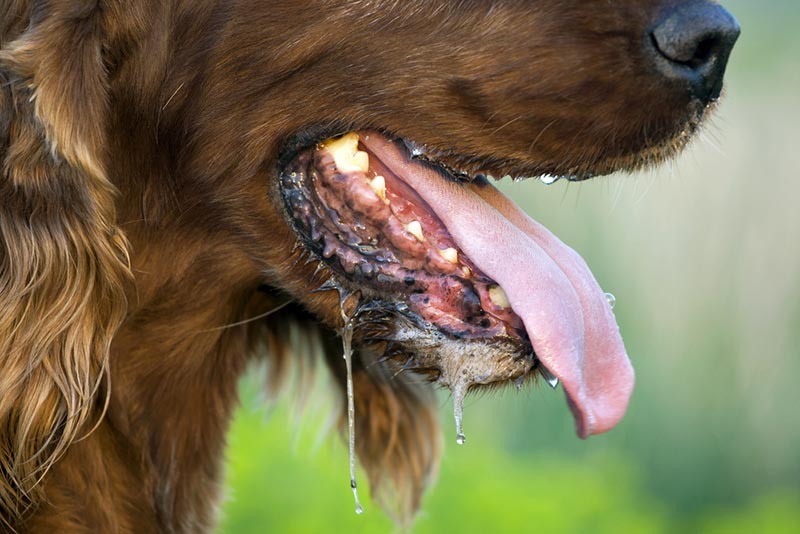Do Dogs Eat Frogs? Vet-Reviewed Health Concerns
Updated on

It’s no secret that dogs are curious animals that take an interest in the world around them. Things that move are almost certainly going to get your dog’s attention, whether it’s animals or leaves. It’s not uncommon for dogs to spot frogs and toads and follow them. Sometimes, your dog might try to eat the unfortunate amphibian, only for your dog to suddenly become the unfortunate one when they realize how unpleasant frogs and toads actually taste. Will a dog actually eat a frog, though? If so, should you be concerned?
Yes, dogs are able to eat frogs, so here’s what you should know if your dog manages to eat one.
Will Most Dogs Eat Frogs?
The good news is that most dogs won’t make it through the action of consuming a frog. Frogs and toads give off an extremely unpleasant taste when threatened, which usually not only results in your dog spitting the critter out but also drooling, panting, or acting like they’re trying to get something out of their mouth. However, some dogs will eat a frog faster than they realize how unpleasant it tastes.

Are Frogs Toxic to Dogs?
There are no native frogs in the United States that are considered severely toxic to dogs, but there are toads that are incredibly toxic to dogs. Although it’s best to contact your vet if your dog consumes any type of amphibian, it’s good to be able to tell the difference between frogs and toads so you can let your vet know what your dog consumed1.
Although they can be similar in appearance, there are a few notable differences between frogs and toads. Frogs tend to have a more athletic body, with long legs and a lean body made for jumping. They tend to have smooth, slightly slimy or sticky skin. They also have a tendency to stay near bodies of water, but this isn’t true of all frog species.
On the other hand, toads tend to have a heavier build with shorter legs. They can hop like frogs, but you will also spot toads crawling. They often have a broader head than frogs. Toads have dry, bumpy skin, and they can be found independent of water sources. In the United States, there are two primary toad species that are toxic to dogs: the Cane toad and the Colorado River toad.
The Cane toad is a large toad with prominent triangular glands behind its eyes and a head that is free of ridges. This is an invasive species of toad that is considered to be one of the worst invasive species in the world. Currently, they are not usually found outside of Florida, Texas, Arizona, New Mexico, California, and Hawaii.
The Colorado River toad, also called the Sonoran Desert toad, is a large toad species that has prominent ridges on its face, as well as prominent glands behind the eyes and on the hind legs. These hefty toads are native to the American Southwest and can be found in Florida, Texas, Arizona, New Mexico, and Hawaii.

Signs of Toad Toxicity
The good news is that if you live outside of the aforementioned regions, then you are extremely unlikely to encounter a toxic toad. Regardless, if your dog consumes a frog or toad, contact your vet with a description of the animal.
If your dog consumes a poisonous toad, they may begin to exhibit signs of toxicity very quickly. While drooling and pawing at their mouth can indicate that they had an unpleasant-tasting toad in their mouth, these can also be signs of toxicity. Other signs include vocalizing, disorientation, walking in circles, falling or poor balance, and seizures. The toxins released by these toads can impact the nervous and cardiovascular systems, leading to death if left untreated.
In Conclusion
It’s not ideal for your dog to eat a frog or toad under any circumstances, but if you live in a region where the Cane toad or Colorado River toad also live, then there is a risk of serious illness and even death if your dog consumes one of these animals. Familiarize yourself with the appearance of these toads if they live near you so you can determine if your dog consumes one. Even if your dog licks one or gets one in their mouth, it’s best to get them to the vet as soon as possible to produce the best outcomes.
The best way to keep your dog safe is to train them to leave frogs and toads alone. In many cases, these are native animals that are an essential part of your local ecosystem. They should be able to live their lives without harassment from your dog. This can be difficult to train, especially if your dog has a high prey drive, so you may need to reach out to a trainer for guidance.
See also:
- Chihuahuas vs Pitbulls: The Differences (With Pictures)
- Why Does My Cat Lick My Blanket: 7 Typical Reasons
Featured Image Credit: Trotskaya Nastassia, Shutterstock












